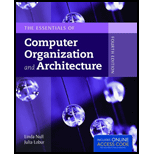
a)
Non-return-to-zero method:
- It is one of the data encoding technique. This method has binary code to represent the significant notation. The binary number “1” represents the positive voltage and “0” represents the negative voltage.
- Each bits occupies certain space of the storage disk, these speck is called bit cell.
b)
Non-return-to-zero-invert method:
It is similar to NRZ. The difference is that the transition depends on the current state for every “1” and state “0” has no transition provided in signal.
c)
Manchester code:
It is an encoding method used in the transmission of data which provides the transition for each bit whether it is one or zero. It is otherwise called as phase modulation method (PM).
- The signal transition is “1” when the transition signaled to “up”.
- The signal transition is “0” when the transition signaled to “down”.
Explanation of Solution
d)
Frequency modulation:
It is similar to the Manchester encoding method. The transition is provided in every bit sequence. The additional transition is provided in middle of each cell for every “1”...
Explanation of Solution
e)
Modified frequency modulation:
It is an improvement over the frequency modulation coding. The transition happened at the boundaries between the cells with two consecutive zeros...
f)
Run-length-limited code:
It is an encoding method which translates the character code like ASCII or EBCDIC into code words. The function RLL (d, k) allows a minimum of “d” and maximum of “k” consecutive zeros which are appear between any pair for consecutive ones.
Want to see the full answer?
Check out a sample textbook solution
Chapter 2 Solutions
The Essentials of Computer Organization and Architecture
- using r language Obtain a bootstrap t confidence interval estimate for the correlation statistic in Example 8.2 (law data in bootstrap).arrow_forwardusing r language Compute a jackknife estimate of the bias and the standard error of the correlation statistic in Example 8.2.arrow_forwardusing r languagearrow_forward
- using r languagearrow_forwardThe assignment here is to write an app using a database named CIT321 with a collection named students; we will provide a CSV file of the data. You need to use Vue.js to display 2 pages. You should know that this assignment is similar, all too similar in fact, to the cars4sale2 example in the lecture notes for Vue.js 2. You should study that program first. If you figure out cars4sale2, then program 6 will be extremely straightforward. It is not my intent do drop a ton of new material here in the last few days of class. The database contains 51 documents. The first rows of the CSV file look like this: sid last_name 1 Astaire first_name Humphrey CIT major hrs_attempted gpa_points 10 34 2 Bacall Katharine EET 40 128 3 Bergman Bette EET 42 97 4 Bogart Cary CIT 11 33 5 Brando James WEB 59 183 6 Cagney Marlon CIT 13 40 GPA is calculated as gpa_points divided by hrs_attempted. GPA points would have been arrived at by adding 4 points for each credit hour of A, 3 points for each credit hour of…arrow_forwardI need help to solve the following case, thank youarrow_forward
 Database System ConceptsComputer ScienceISBN:9780078022159Author:Abraham Silberschatz Professor, Henry F. Korth, S. SudarshanPublisher:McGraw-Hill Education
Database System ConceptsComputer ScienceISBN:9780078022159Author:Abraham Silberschatz Professor, Henry F. Korth, S. SudarshanPublisher:McGraw-Hill Education Starting Out with Python (4th Edition)Computer ScienceISBN:9780134444321Author:Tony GaddisPublisher:PEARSON
Starting Out with Python (4th Edition)Computer ScienceISBN:9780134444321Author:Tony GaddisPublisher:PEARSON Digital Fundamentals (11th Edition)Computer ScienceISBN:9780132737968Author:Thomas L. FloydPublisher:PEARSON
Digital Fundamentals (11th Edition)Computer ScienceISBN:9780132737968Author:Thomas L. FloydPublisher:PEARSON C How to Program (8th Edition)Computer ScienceISBN:9780133976892Author:Paul J. Deitel, Harvey DeitelPublisher:PEARSON
C How to Program (8th Edition)Computer ScienceISBN:9780133976892Author:Paul J. Deitel, Harvey DeitelPublisher:PEARSON Database Systems: Design, Implementation, & Manag...Computer ScienceISBN:9781337627900Author:Carlos Coronel, Steven MorrisPublisher:Cengage Learning
Database Systems: Design, Implementation, & Manag...Computer ScienceISBN:9781337627900Author:Carlos Coronel, Steven MorrisPublisher:Cengage Learning Programmable Logic ControllersComputer ScienceISBN:9780073373843Author:Frank D. PetruzellaPublisher:McGraw-Hill Education
Programmable Logic ControllersComputer ScienceISBN:9780073373843Author:Frank D. PetruzellaPublisher:McGraw-Hill Education





